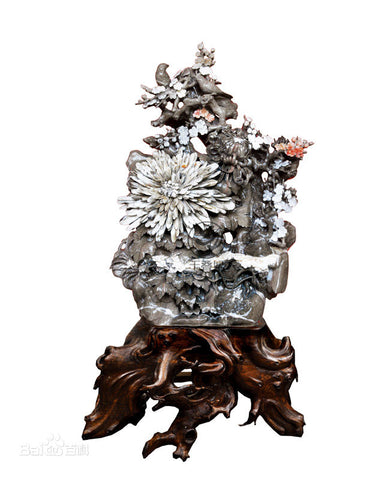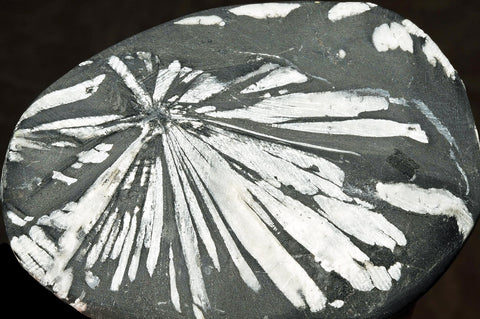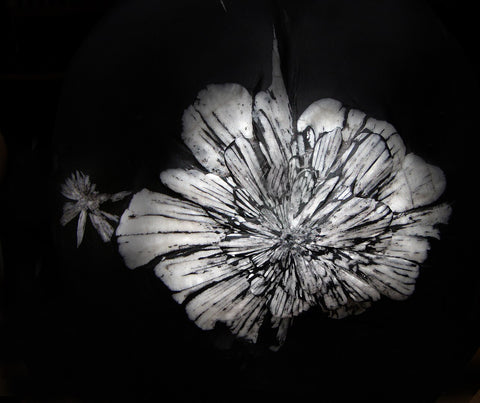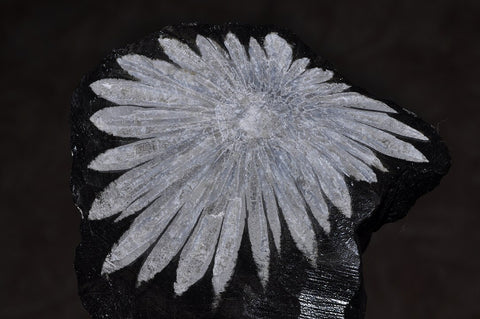What is Chrysanthemum Stone? This rare gemstone features unique flower patterns echoing the beauty of chrysanthemum flowers. It is often unearthed in China and boasts a deep connection to Earth’s geological history and cultural significance. Our exploration will reveal why this stone, known as Chrysanthemum Stone, is sought after in collections and spiritual practices.
Introduction to Chrysanthemum Stone
The Chrysanthemum Stone is a rare and unique gemstone that has been prized for its beauty and metaphysical properties for centuries. Also known as the “Flower Stone,” this captivating gem is characterized by its intricate, flower-like patterns that resemble chrysanthemum blossoms. These natural formations are visually stunning and imbued with a powerful energy that can bring balance, harmony, and spiritual growth to those who possess it.
The Chrysanthemum Stone’s allure extends beyond its physical appearance. It is said to possess a profound spiritual energy that aids in grounding and protection, making it a cherished stone in various healing and spiritual practices. Whether used in meditation, crystal healing, or as a decorative piece, the Chrysanthemum Stone inspires and enchants those who encounter it. This article will delve into the rich history, unique properties, and numerous benefits of the Chrysanthemum Stone, exploring its uses in healing, meditation, and spiritual practices.
Key Takeaways
-
Chrysanthemum Stone is treasured for its unique flower-like crystal formations and its origin in diverse geological processes, predominantly found in China, Japan, Canada, and the United States.
-
The stone's mineral composition, including andalusite, calcite, and dolomite, influences both its healing properties and its physical characteristics, such as colour variations and crystallographic symmetry.
-
Beyond its aesthetic value, the Chrysanthemum Stone has significant metaphysical properties, offering grounding, protection, and emotional balance. It is integrated with practices like Feng Shui to harmonize spaces.
Exploring the Essence of Chrysanthemum Stone: The Flower Stone

Also known as the ‘flower stone,' the Chrysanthemum Stone captivates gemstone enthusiasts with its intricate patterns and naturally formed white chrysanthemum flower-shaped crystals. This enchanting allure and its distinctive appearance make it appealing to gemstone collectors and enthusiasts alike. The flower stone was initially discovered in Liuyang, Hunan Province, China, intertwining it with Chinese culture for centuries.
Setting itself apart from other gemstones, the Chrysanthemum Stone embodies millions of years of geological shifts and natural phenomena. It is a testament to the earth's magnificent ability to create beauty through time, each stone a unique masterpiece.
The Formation Journey: Million Years in the Making
Picture the development of mineral inclusions and crystalline structures within a rock over millions of years, shaped by diverse geological processes. Such is the formation process of the Chrysanthemum Stone, resulting in the unique chrysanthemum petals pattern that graces its surface. Chrysanthemum Stone was formed during the Permian age of the Paleozoic era, about 248 to 290 million years ago.
These stones are predominantly located in:
-
Guangdong, Hunan, and Hubei provinces in China
-
Japan
-
Canada
-
United States
Their occurrence varies, with black and brown as frequent colour variations of the chrysanthemum stone. Despite its occurrence in these areas, it is regarded as a comparatively uncommon and precious stone, further enhancing its appeal.
Unraveling the Mineral Composition
The intricate mineral composition forms the core of the Chrysanthemum Stone, an excellent support stone. Andalusite, the main component of the stone, contributes significantly to its unique patterns and appearance. The stone inspires many collectors and enthusiasts with its captivating beauty.
Calcite and dolomite play an integral role in the stone's composition. These minerals contribute to the stone's healing properties and play a significant role in its physical properties. Feldspar, for instance, influences the stone's crystallographic symmetry and pleochroism, providing a deeper appreciation of the Chrysanthemum Stone's unique characteristics.
A Tapestry of Color: Black, Brown, and Beyond
The Chrysanthemum Stone, including the black chrysanthemum stone, presents a vibrant spectrum of colours. It typically appears in dark gray or black but can exhibit tones of:
-
white
-
brown chrysanthemum stone
-
blue
-
green
-
gray
-
red
-
orange
-
yellow
-
pink
-
silver
-
purple
These different colours are due to the presence of various minerals, such as calcite and dolomite. These minerals promote overall well-being and significantly influence the stone's properties.
Despite the array of colours, the stone's energetic properties are determined more by its patterns and minerals, which resemble the cheerful flower of the chrysanthemum.
The Art of Chrysanthemum Stone Carving

Generations have passed down the craft of carving the Chrysanthemum Stone. Skilled artisans transform raw stones into intricate designs, sculptures and decorative pieces using:
-
miniature tools
-
a sander
-
various engraving methods including grinding along the central axis of the petals, engraving lines, reliefs, circular sculptures, and hollow carvings.
Carving the Chrysanthemum Stone requires precision and attention to detail to showcase its beauty due to its intricate patterns, hardness, and density. With its profound historical significance, this art form has been around for more than 260 years, primarily in Hunan, China.
Conventional carvings frequently showcase designs such as irises and shapes like the claw flower and cylindrical flower.
Metaphysical Properties: More Than Just a Pretty Stone
The metaphysical properties of chrysanthemum stones are admired for their physical beauty and spiritual, emotional, and physical benefits. Renowned for its grounding and protective attributes, it symbolizes stability, protection, and fortitude, offering a sense of sanctuary and aiding individuals in maintaining a grounded and secure state.
In addition to its grounding and protective qualities, Chrysanthemum Stone also fosters:
-
Balance and harmony, which chrysanthemum stone lends to its surroundings
-
Calmness
-
Alleviation of depression
-
Enhancement of happiness
-
Creation of a tranquil and balanced environment
-
Purification benefits, such as aiding in self-healing, providing clarity, facilitating transformation, and fostering a connection with one’s inner self and higher spiritual realms
These qualities are highly esteemed.
Chrysanthemum Stone in Healing Practices

The Chrysanthemum Stone is highly regarded in the physical healing communities. It offers the following benefits:
-
Strength and potency
-
Alleviates concerns associated with physical well-being
-
Assists in the restoration of eye and ear health
-
Promotes healthy skin and hair
-
It Fosters a general feeling of physical well-being and vigour.
Additionally, the Chrysanthemum Stone is considered an excellent fertility stone, particularly beneficial for both men and women trying to conceive. It supports women's reproductive health, especially in mitigating issues caused by fibroid masses or cystitis, and is an ideal gift for pregnancy and birth.
On the emotional front, Chrysanthemum Stone:
-
Empowers individuals by promoting a sense of calm and relaxation
-
Aids in the exploration of one’s inner self and connection to higher spiritual realms
-
Represents optimism and conveys the belief in attainable abundance and blessings.
Furthermore, it contributes to the balance and stabilization of chakras and the aura, utilizing Metal energy to promote:
-
intelligence
-
healing
-
creativity
-
a harmonious balance between the spiritual realm and the physical world
This enhances one’s spiritual connection to their physical body.
Integrating Chrysanthemum Stone with Other Gemstones
When paired with gemstones like Hematite, Smoky Quartz, or Quantum Quattro, the Chrysanthemum Stone's energy can be enhanced, providing further benefits. The combination of Chrysanthemum Stone with:
-
Hematite can improve circulation, aid in blood disorders, assist with anemia, promote iron absorption, and enhance the interpretation of dream meanings.
-
Smoky Quartz can provide grounding and protection, alleviate stress and anxiety, and promote emotional healing.
-
Quantum Quattro can enhance spiritual growth, balance the chakras, and promote overall well-being.
Similarly, pairing Chrysanthemum Stone with Smoky Quartz enhances stability, abundance, and practicality by establishing a connection to the grounding and stabilizing energies of the Earth. Integrating Chrysanthemum Stone with Quantum Quattro amplifies both stones' vibration and healing effectiveness, enhances emotional connections, instills feelings of compassion and forgiveness, and facilitates profound healing across various levels.
Feng Shui and Chrysanthemum Stone: Harmonizing Your Space

According to Feng Shui principles, Chrysanthemum Stone embodies Metal energy, symbolizing:
-
intelligence
-
contraction
-
healing
-
creativity
It enhances concentration and determination in specific areas of a home, making it an excellent addition to spaces that require high focus or are used for group collaboration, and understanding how the two work together is essential for maximizing productivity.
In accordance with Feng Shui principles, Chrysanthemum Stone is conventionally positioned in the central area of a home to promote health, wellness, and enduring prosperity. Its serene and assured energy permeates its surroundings, fostering a harmonious and balanced environment.
The Cultural Significance of Chrysanthemum Stone in China

The deep cultural significance of the Chrysanthemum Stone in China is indisputably profound. The stone was first discovered in the Hunan Province of China in the early 20th century. Associated with the symbolism of autumn, it represents the season of harvest and joy, longevity, affluence, and the desire for a peaceful retirement. It is also linked to qualities such as cleanliness, purity, unity, and innocence. The Chinese people call the Chrysanthemum Stone the "Stone of Wealth and Honor."
The stone is used in Chinese ceremonies and rituals to symbolize longevity, nobility, and elegance. Its connection with the official symbol of the Chinese Imperial Family further underlines its significance. Chinese myths frequently incorporate Chrysanthemum Stone, symbolizing everlasting love, with tales from the Qing Dynasty recounting immortal lovers who metamorphosed into chrysanthemum stones.
Chrysanthemum Stone in Ancient Lore and Legend
The Chrysanthemum Stone has a rich history that dates back to ancient China, where it was highly valued for its beauty and spiritual significance. According to legend, the Chrysanthemum Stone was formed from the souls of old chrysanthemums in the sky, imbuing it with the power to bring good fortune, longevity, and happiness to those who possessed it. This enchanting tale adds a layer of mystique to the stone, making it a cherished symbol of prosperity and joy.
In Chinese culture, the chrysanthemum flower symbolizes autumn, representing the season of harvest and joy. With its flower-like patterns, the Chrysanthemum Stone embodies these qualities, making it a revered stone during the autumn season. It was also said to be a favourite of the Chinese Imperial Family, who prized it for its beauty and spiritual significance. The stone’s connection to the Imperial Family further underscores its esteemed status in Chinese history.
The Chrysanthemum Stone is still highly valued for its unique properties and is used in various spiritual and healing practices. Its timeless beauty and profound symbolism continue to captivate and inspire, making it a treasured gem in both historical and modern contexts.
Chrysanthemum Stone's Role in Modern Spirituality
Modern spirituality embraces the Chrysanthemum Stone for its transformative properties, spiritual energy and its link with universal wisdom. It promotes crystal healing through:
-
Inner wisdom
-
Clarity
-
Self-healing energies
-
Discovering true purpose
-
Cultivating a state of tranquility and equilibrium
Chrysanthemum Stone contributes to meditation and inner reflection by improving:
-
Compassion
-
Fertility
-
Peace
-
Intuition
-
Spiritual growth
-
Protection
-
Grounding
-
Manifestation
-
Inner peace
-
Tranquility
-
Release of negative emotions
It acts as a channel for abundance and prosperity, exuding a serene and assured positive energy that permeates its surroundings. It enhances compatibility, trust, peace, and balance, facilitating the connection between the spiritual and physical realms and contributing to a tranquil and harmonious spiritual journey.
Chrysanthemum Stone can be used for chakra healing. It can clear the meridians of the physical body from the Root Chakra to the Crown Chakra and stimulate both. The Root Chakra is located at the base of the spine and controls energy for kinesthetic feeling and movement. When the Root Chakra is balanced, it leads to feelings of safety, security, and increased confidence.
The Crown Chakra is located at the top of the head. It is a gateway to the expanded universe and controls one’s beliefs and spirituality. It plays a crucial role in maintaining spiritual and physical equilibrium.
Additionally, Chrysanthemum Stone balances the spiritual and physical worlds, encouraging individuals to connect their spiritual growth with their physical existence.
Chrysanthemum Stone influences spiritual energies, which are essential for overall well-being. When spiritual energies are balanced, individuals experience a sense of vitality and connection to reality, enhancing both physical and spiritual health.
Practical Tips for Caring for Your Chrysanthemum Stone
As with any precious gemstone, maintaining the beauty and energy of the Chrysanthemum Stone requires appropriate care. Regular cleaning using a soft brush or microfiber cloth can help remove dirt and buildup, and a mild liquid dish soap or safe jewelry cleaner can help maintain the gem and metal's shine.
When wearing Chrysanthemum Stone jewelry, refrain from wearing it immediately after using creams, perfumes, or similar body products, as these substances can damage the gemstones and leave a residue that diminishes their lustre. After cleaning, once the jewelry is thoroughly dried, it is advisable to store it in a jewelry box with a lid and lining to safeguard the stone from potential harm and preserve its overall quality.

Summary
The Chrysanthemum Stone, with its unique flower-like patterns, enchanting colours, and metaphysical properties, bridges the physical and spiritual realms. Whether in art, healing practices, or spiritual practices, the stone continues to captivate and inspire. Its timeless beauty and profound symbolism make it more than just a pretty stone—it's a gem that brings harmony, balance, and abundance into our lives.
Frequently Asked Questions
What is the chrysanthemum stone good for?
The Chrysanthemum stone is good for healing work, inspiring, revitalizing, and lifting depression, increasing friendship and happiness, and dispelling ignorance, bigotry and self-righteousness, ultimately bringing the joy of achievement.
What is another name for chrysanthemum stone?
Chrysanthemum stone is also known as Flower Stone due to its unique flower-like pattern and geological formation.
What colour is chrysanthemum stone?
Chrysanthemum stone is dark gray to black in colour with naturally formed white chrysanthemum-shaped crystals. The "flowered" inclusions give it the reputation as the "Stone of Wealth and Honor."
What are the primary minerals that make up the Chrysanthemum Stone?
The primary minerals that make up Chrysanthemum Stone are Andalusite, Calcite, and Dolomite. These minerals combine to create the unique patterns seen in the stone.









